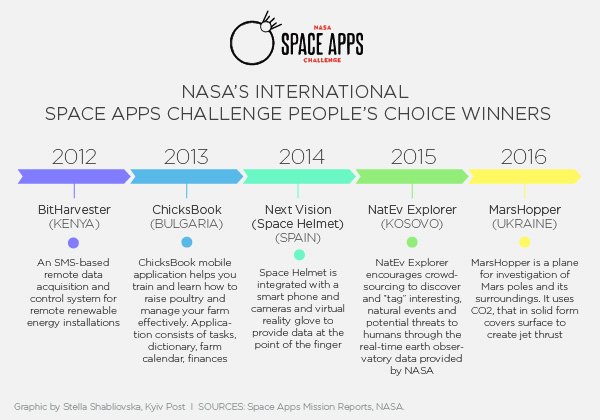A team of Ukrainians has won an award from a NASA innovation project with their radical new design idea for a space probe to explore the planet Mars.
The team of seven came up with a design for a “Mars Hopper” – a robotic probe fueled by carbon dioxide that can skip around the surface of the red planet. With it, the team won the “People’s Choice” award from NASA’s Space Apps, an annual hackathon that encourages the public around the world to get involved in innovative research into space exploration and Earth-based problems.
During the two stages of the hackathon – a local stage in Kyiv and a global one in Pasadena, California – the Ukrainian team created a prototype mobile laboratory that looks like an aircraft and uses carbon dioxide ice scooped from the surface of Mars as fuel.
“If we want to colonize Mars, it has to be examined in detail,” one of the team, Mykola Denysenko, 26, told the Kyiv Post. “There’s a lot of data to investigate before we can start planning space trips there.”
The infographic below explains how Ukrainian team’s aircraft might operate on Mars.

The concept isn’t new, however – scientists from Idaho National University in 2011 published a paper on creating a device that could fuel itself on Mars by collecting CO2, and “hopping” across the planet to explore wide areas.
And in 2013 a U.K. team proposed building a vehicle powered by a radioisotope thermal rocket engine also using CO2 as a propellant, similar to the one the Idaho scientists proposed.
However, the Ukrainian team is the first to create an accurate computer simulation of a Mars Hopper that uses a “nuclear-CO2” engine, proving the idea is feasible.
“We don’t know why they stopped doing their research. Maybe there was no investment in it,” Denysenko told the Kyiv Post, referring to the earlier attempts to develop a Mars Hopper.
NASA’s spokesperson Eldora Valentine told the Kyiv Post that in case Mars Hopper team moved forward with their project design, they would need to “do their homework and rule out any similarities” with other patented projects.
If the Mars Hopper team wants to pursue U.K. and U.S. scientists’ ideas, which are open source, “they may want to reach out to the authors (of previous research) for advice,” Valentine said.
In theory, the Ukrainian device, if built, could automatically take samples from the surface of Mars, analyze them and transmit the results to the Earth. As it “hops” around the surface, it scoops up frozen CO2, which is converted into rocket fuel by a radioactive heat source.
The only alternative source of energy that might have been also used was solar, but “the panels used in space are too heavy” and, moreover, “it’s almost dark on Mars,” Denysenko told the Kyiv Post. “Frozen carbon dioxide, on the other hand, covers the planet – it’s ubiquitous there.”
Once it has collected enough CO2, the Mars Hopper fires a jet to thrust it off the surface and into the thin Martian atmosphere, where, with the aid of propellers also fueled by CO2 propellant, it can fly and glide to another position to take fresh samples.
Mars Hopper’s co-authors Mykola Denysenko (L) and Andrii Muzychenko pose for a picture after an interview with the Kyiv Post on May 31. © Anastasia Vlasova
The device’s name, Mars Hopper, was derived from the style of its movement: it jumps and then glides – somewhat like a grasshopper.
Taking into account the conditions on Mars, the Ukrainian team has calculated that the device should weigh no more than 200 kilograms (440 pounds) and have an 8.5-meter (334-inch) wingspan. It could reach speeds of up to 360 kilometers (223 miles) per hour.
Its fuselage is to be made of light composite materials, with all of the scientific equipment concentrated in the forward area. Special landing gear will allow the device to land like an aircraft on the icy surfaces of Mars.
The team is currently planning to create two prototypes of the aircraft to test both its aerodynamics and other functions on Earth. Almost all the materials they require can be found in Ukraine, apart from the isotopic thermo-electric generator – the system that actually converts the CO2 into propellant.

The Mars Hopper team has no plans to leave Ukraine to work for NASA or other space agencies, a co-author of the project Andrii Muzychenko told the Kyiv Post. He said that even if the famous U.S. aerospace manufacturer SpaceX offered them a job, they would agree only if they could work from Ukraine.
“So many people have left the country, so many startups,” Muzychenko said. “Enough!”
Muzychenko and Denysenko agree, however, that they will make a trip to the United States if their invention is one day built and launched on a mission to Mars.
According to the Mars Hopper team, winning the NASA award will help them advertise their work and link up with people who could contribute to the project.
“We want to finish the project no matter what’s ahead,” Muzychenko said. “But we won’t be able to afford it without investment. We created a model from a plastic bottle, polyfoam, and dry ice, but we need money to continue.”
NASA’s Space Apps challenge has been held every year since 2012, but this was the first time a team from Ukraine has participated in the competition.
“We’ve managed to show that Ukraine, apart from just generating cool ideas, can also place well and eventually even win such competitions,” Denysenko said.
Kyiv Post staff writer Denys Krasnikov can be reached at [email protected]. The Kyiv Post’s IT coverage is sponsored by Beetroot, Ciklum, Steltec Capital, 1World Online and SoftServe. The content is independent of the donors.

